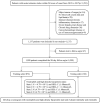A Nomogram That Includes Neutrophils and High-Density Lipoprotein Cholesterol Can Predict the Prognosis of Acute Ischaemic Stroke
- PMID: 35280284
- PMCID: PMC8914087
- DOI: 10.3389/fneur.2022.827279
A Nomogram That Includes Neutrophils and High-Density Lipoprotein Cholesterol Can Predict the Prognosis of Acute Ischaemic Stroke
Abstract
Lipids are implicated in inflammatory responses affecting acute ischaemic stroke prognosis. Therefore, we aimed to develop a predictive model that considers neutrophils and high-density lipoprotein cholesterol to predict its prognosis. This prospective study enrolled patients with acute ischaemic stroke within 24 h of onset between January 2015 and December 2017. The main outcome was a modified Rankin Scale score ≥3 at the 90th day of follow-up. Patients were divided into training and testing sets. The training set was divided into four states according to the median of neutrophils and high-density lipoprotein cholesterol levels in all patients. Through binary logistic regression analysis, the relationship between factors and prognosis was determined. A nomogram based on the results was developed; its predictive value was evaluated through internal and external validations. Altogether, 1,090 patients were enrolled with 872 (80%) and 218 (20%) in the training and testing sets, respectively. In the training set, the major outcomes occurred in 24 (10.4%), 24 (11.6%), 37 (17.2%), and 49 (22.3%) in states 1-4, respectively (P = 0.002). Validation of calibration and decision curve analyses showed that the nomogram showed better performance. The internal and external testing set receiver operating characteristics verified the predictive value [area under the curve = 0.794 (0.753-0.834), P < 0.001, and area under the curve = 0.973 (0.954-0.992), P < 0.001, respectively]. A nomogram that includes neutrophils and high-density lipoprotein cholesterol can predict the prognosis of acute ischaemic stroke, thus providing us with an effective visualization tool.
Keywords: high-density lipoprotein cholesterol; neutrophil; nomogram; prognosis; stroke.
Copyright © 2022 Wang, Liu, Tian, Liang, Sun, Zhang, Pei, Liu, Sun, Wu, Gao, Xu, Wang and Song.
Conflict of interest statement
The authors declare that the research was conducted in the absence of any commercial or financial relationships that could be construed as a potential conflict of interest.
Figures




Similar articles
-
Development and Validation of a Nomogram for Lower Extremity Deep Venous Thrombosis in Patients after Acute Stroke.J Stroke Cerebrovasc Dis. 2021 May;30(5):105683. doi: 10.1016/j.jstrokecerebrovasdis.2021.105683. Epub 2021 Mar 4. J Stroke Cerebrovasc Dis. 2021. PMID: 33676327
-
A SCANO Nomogram for Individualized Prediction of the Probability of 1-Year Unfavorable Outcomes in Chinese Acute Ischemic Stroke Patients.Front Neurol. 2020 Jun 30;11:531. doi: 10.3389/fneur.2020.00531. eCollection 2020. Front Neurol. 2020. PMID: 32695060 Free PMC article.
-
Triglyceride to high-density lipoprotein cholesterol ratio predicts worse outcomes after acute ischaemic stroke.Eur J Neurol. 2017 Feb;24(2):283-291. doi: 10.1111/ene.13198. Epub 2016 Nov 14. Eur J Neurol. 2017. PMID: 27862659
-
Predictive Value of the Systemic Immune Inflammation Index for Adverse Outcomes in Patients With Acute Ischemic Stroke.Front Neurol. 2022 Mar 18;13:836595. doi: 10.3389/fneur.2022.836595. eCollection 2022. Front Neurol. 2022. PMID: 35370926 Free PMC article.
-
Nomogram for predicting transmural bowel infarction in patients with acute superior mesenteric venous thrombosis.World J Gastroenterol. 2020 Jul 14;26(26):3800-3813. doi: 10.3748/wjg.v26.i26.3800. World J Gastroenterol. 2020. PMID: 32774059 Free PMC article.
Cited by
-
Genetic variation within the pri-let-7f-2 in the X chromosome predicting stroke risk in a Chinese Han population from Liaoning, China: From a case-control study to a new predictive nomogram.Front Med (Lausanne). 2022 Nov 30;9:936249. doi: 10.3389/fmed.2022.936249. eCollection 2022. Front Med (Lausanne). 2022. PMID: 36530894 Free PMC article.
-
The Aggregate Index of Systemic Inflammation as a Predictor of Mortality in Stroke Patients.Cureus. 2024 Jul 7;16(7):e64007. doi: 10.7759/cureus.64007. eCollection 2024 Jul. Cureus. 2024. PMID: 39109115 Free PMC article.
-
Neutrophil extracellular traps mediated by platelet microvesicles promote thrombosis and brain injury in acute ischemic stroke.Cell Commun Signal. 2024 Jan 17;22(1):50. doi: 10.1186/s12964-023-01379-8. Cell Commun Signal. 2024. PMID: 38233928 Free PMC article.
References
-
- Collaborators GDaH . Global, regional, and national disability-adjusted life-years (DALYs) for 359 diseases and injuries and healthy life expectancy (HALE) for 195 countries and territories, 1990–2017: a systematic analysis for the global burden of disease study 2017. Lancet. (2018) 392:1859–922. 10.1016/S0140-6736(18)32335-3 - DOI - PMC - PubMed
LinkOut - more resources
Full Text Sources

